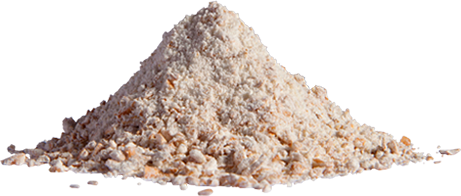FLOUR
Overview:
Flour is the term used for the powdery substance resulting from the grinding, milling or pulverizing of grains, seeds, roots or other edible materials. Wheat, rye, oats, rice, corn, taro root, and cassava are some examples of grains and roots that are ground into flour, primarily for baking. Flour is the main ingredient in bread, which is a staple food in most cultures.
In common usage, flour refers to wheat flour. Wheat grains are composed of a starchy inner portion, called the endosperm, which makes up 85% of the grain kernel; the outer layers, known as bran, and the oily wheat germ comprise the remainder. The milling process separates out the endosperm and reduces it to fine particles.
While generally innocuous in itself, soy flour, oat flour, potato flour, rice flour, rye flour and wheat flour are all classified as "combustible dusts" by the United States Occupational Safety and Health Administration and the handling of these flours is subject to standards used by this agency to mitigate the risks of dust explosions.1 There is an average of ten wheat grain mill explosions in the United States per year,2 some with devastating consequences. These explosions are usually caused by the presence of a "fire triangle," that includes oxygen, an ignition source and a fuel, such as flour dust.
Characteristics and Challenges:
Because of the potentially explosive nature of flour dust, suppression and collection are of vital importance when transporting flour. If the flour arrives at the processing facility in bulk bags, the frames used to discharge the bags usually require additional interface devices to collect dust and ensure an airtight sealed process.
If the flour is packaged in smaller bags, a bag-breaking station with a dust hood, filtration devices and a pneumatic pulse cleaner may be sufficient to support the manual unloading of the material.
As the flour fills the receiving hopper, the air inside of the hopper is forced through a static filter, increasing the possibility of airborne flour dust particles escaping into the surrounding atmosphere. This potentially creates one of the fire triangle conditions. A dust collector mounted on the discharger frame will contain the flour dust inside the conveyance system.
This not only lowers the amount of housekeeping efforts necessary, but the collector can also reduce product waste if it is equipped with a reverse pulsejet which pneumatically cleans the filter media, blowing the trapped dust back into the receiving hopper.
In addition to containing dust, an understanding of the flow properties of flour is important for its successful transport. The characteristics of flour vary, depending on the type of material milled to make the flour, the climate indigenous to the region the material grew in and the methods used to mill the material(s) into flour. Generally, flour is free flowing and will flood conveying lines. Care must be taken when activating the vessels containing the flour, as it is aeratable. Consultation with an expert is recommended for selecting the best system and engineering it to meet individual flour handling needs.
If the flour is being pneumatically conveyed into a processing system, the blower used to move the air line must be sized to meet the demands of system. If a flexible screw is being used to convey the flour, it is important to use a screw that matches the flour's characteristics and other application requirements. Generally a screw with a wider, flatter surface is necessary for moving flour up an incline. A removable clean out cap and reversible direction on the screw will assist in clean up and product changeovers.
Some flours will tend to agglomerate, "rat hole" or bridge in hoppers, interrupting the flow of the material. Feed hoppers should be designed with proper geometry and may need to incorporate devices such as vibrators or mechanical agitators to promote flow. A hopper screen above the receiving vessel will help protect the operators if the flour is being dumped manually into a hopper that is equipped with agitating devices.
Should your flour application feature the loading of bulk bags, the use of load cells and vibratory densification decks will greatly maximize the capacity of the bulk bags.
Flexicon Applications:
An organic food manufacturer conveys ingredients having disparate particle sizes without separating blends.
Consultation with a Flexicon specialist will help you decide if a flexible screw or pneumatic solution best fits your flour application. Flexicon's expert design and engineering staff will weigh each parameter and recommend the best solution for you. Upon request, Flexicon's test lab will simulate your sugar handling functions before the system is installed in your plant.
Flexicon's Dust Suppression and Collection Systems ensure proper containment of flour throughout the conveyance process. Flexicon's High Flow Hopper, purpose-built for flexible screw conveyors, increases the flow of both free- and non-free-flowing bulk materials while eliminating or decreasing the amount of residual material in the hopper as well as the need for flow promotion devices, is perfectly suited for flour handling.
Flexicon's product line of advanced flow promotion conveyors, high flow hoppers, deaeration/densification decks and a host of other components and accessories are proven performers that promote flow while reducing degradation, dusting and/or the separation of blends comprised of disparate particles.
Related Articles on Flour:
1 United States Department of Labor
2 WorldGrain.com: Grain Dust Explosions
Sources: Where noted. All other information courtesy of Flexicon Corporation.